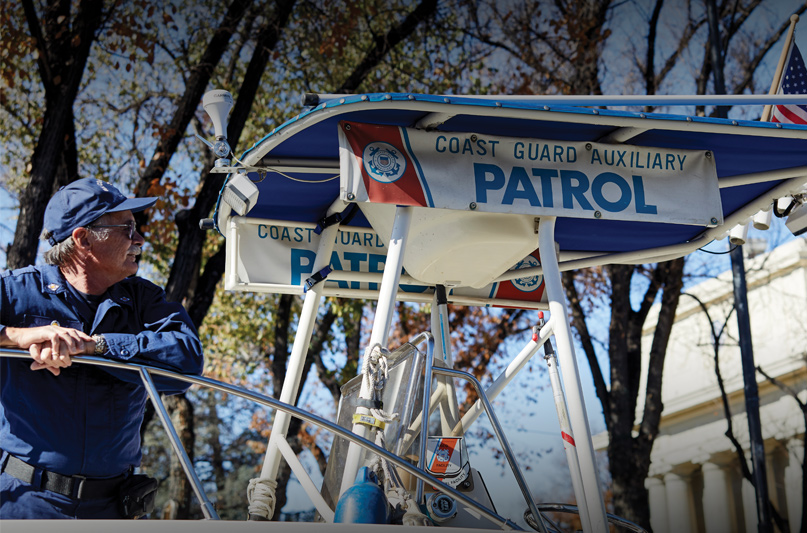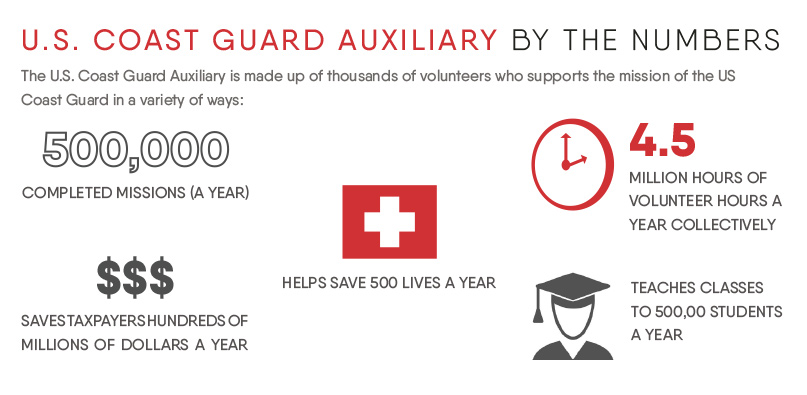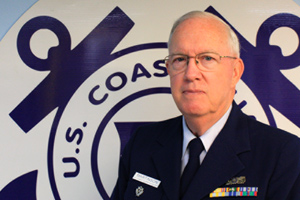“Semper Paratus.”
-Latin phrase meaning “Always Ready” and official motto of the U.S. Coast Guard Auxiliary
 This month we continue with the second part of our interview with US Coast Guard Auxiliarist Richard Martinson (USCG Cmdr. Ret.) who covers the opportunities available to Auxiliarists and boating classes offered by the Auxiliary.
This month we continue with the second part of our interview with US Coast Guard Auxiliarist Richard Martinson (USCG Cmdr. Ret.) who covers the opportunities available to Auxiliarists and boating classes offered by the Auxiliary.
NWY: Last month we talked about the primary public safety and education roles of the Auxiliary. Does active duty USCG use the Auxiliary for more than inspections and teaching classes?
Definitely. Auxiliarists and their boats have also been used to supplement the USCG’s search and rescue boats. As an example; in 1982, the first Trident submarine arrived in Washington, at the Bangor submarine base on Hood Canal which was a big deal. Normally, all submarine activities are classified, so you’re never supposed to know when they are coming and going.
But in this one case, the Navy wanted to put on a show and let the public see what the Navy spent all their tax money on.
Many people came out to see it—an estimated 10,000 people were on the water – but that also included groups protesting nuclear weapons. The Navy became very concerned about this, because the submarine is going to pass through Admiralty Inlet and Hood Canal, some very narrow waterways.
The Navy feared that protesters were going to try and block the submarine by getting in front of it. A Trident submarine is huge with five stories underwater when surfaced, almost 600 feet long, and it can take a mile for them to stop. If some protesters decide to try and block it somehow, it’s going to plow right through anyone in its path and hurt or possibly kill someone in doing so.
So, they came to the USCG and said, ‘You’re the law enforcement body on the water, we need some help.’ And so, under the name “Operation Welcome”, it became the biggest security escort mission that the Navy and USCG were involved in since WWII. I was part of the four-person planning team for the operation.
Sixty-five miles of coastline had to be protected. It takes lots boats to do that, so we stripped the Thirteenth Coast Guard District of every single small boat they had, except the motor lifeboats. This was all taking place during what’s known as SAR (search and rescue) season in August, and, all of a sudden, we’re taking nearly every boat and search and rescue asset.
The question then was what can we use to replace those boats? The other three had no idea what we were going to do, so I brought up the Auxiliary. After that, for two and a half weeks, every search and rescue station you saw on the Washington and Oregon coast, Straits of Juan de Fuca, Puget Sound and Columbia River was filled with Auxiliarists and their boats, which made for a tremendous use of that asset.
That would be harder to do these days, because the requirements and regulations are stricter for civilian boats to be used like that, enhanced law enforcement efforts being the primary issue, but they can still be used to support search and rescue missions.
NWY: Other than the vessel inspections and the educational classes, what ways do Auxiliary members assist the USCG?
Auxiliary members can assist in a number of different ways, as long as it’s not a mission involving military actions or law enforcement. In the 1990s, the USCG opened up all kinds of other roles.
There are Auxiliarists who cook on USCG cutters when they’re in port, who stand watch at communication centers, and go out on safety patrols. Our district has a color guard, and they are available for any number of things—like boating events, parades, funerals, and some USCG activities. They’ll call up this group and they’ll come and perform that ceremonial function. But really many positions in the USCG could be filled by an Auxiliary member.
NWY: Do Auxiliarists’ need training to qualify for certain positions?
Yes, Auxiliarists can fill a lot of roles, but those positions still have qualifications, which could even involve going to a formal course called a C-School. So, if an Auxiliarist would like to do something special, they can go to a C-School and learn about it. Let’s say you want to learn to be a USCG cook. You could go to a C-School and learn how to be a cook. Some Auxiliarists go to a public relations C-School and can qualify to be a public information officer.
An Auxiliarist could even qualify to be a crewman on a cutter. There have been times when Auxiliarists have gone all the way down to Antarctica as crew members on an ice breaker. It’s possible if you get in all the requirements. And if you’ve got the time, because, remember, you’re not being paid for any of this, but things like that have happened more than once.
Sometimes there are shorter missions, like on the large patrol class cutters here in Puget Sound. These are 87-foot boats, stationed locally that go on week long patrols.
If an Auxiliarist qualifies so that he or she will be a useful member of the crew, they could go on one of those patrols. They might just call you up and ask if you’re available because a regular crew member is gone. People who are retired generally are the ones who have time for that.
NWY: How long would it take for an Auxiliary member to get to the point where they were qualified to serve on a USCG cutter or other patrol boat?
There will be a set of standards set up for Auxiliarists, which would mirror the standards for active duty USCG. If you go aboard, whether it’s in port or at sea, and you perform activities like handling the small boat or get training in something like firefighting or communications, once you’ve achieve that successfully, you’ll earn your qualification in that task. Sometimes there will be a short, written exam just to make sure you’ve got everything learned.
On a cutter as an active duty member, if you fully qualify, there is a pin, the USCG has what’s called a Cutterman Pin, which means you qualify as a USCG crewmember, and you get to wear the pin on your uniform. If you’re in the Auxiliary, there is a nearly identical pin, but it has the Auxiliary ‘A’ on it.
But the requirements are fairly extensive to get to that point. It’s a pretty comprehensive thing you would go through, both in the classroom and underway, and you would have to complete a Quality Examination. So, anyone who qualifies for something like being on a cutter is someone who is fully trained and committed.
And of course, an Auxiliarist spending a long period of time underway tends to be a little less common, but these 87-footers that do week long patrols provide a great opportunity. That’s not so bad, and if something came up where the Auxiliarist needed to get off, they could pull in somewhere and let them off.
NWY: Could you describe what classes are offered by the Auxiliary? Are they designed for entry level boaters?
We get some entry-level people, but it’s often people who may go out on the water often, but don’t have any formal training and may be missing some of the fundamentals. The Boating Skills and Seamanship covers everything from trailering your boat to basic engine maintenance and upkeep and, of course, seamanship skills. Then they’ll get into specifics, a couple of classes will be devoted entirely to navigation, where you’ll get everything you need to know about navigation, whether you’re going up and down the Coast, Puget Sound, up to Alaska, or something more adventurous.

The classes cover weather, knot tying, navigation and rules of the road. There’s an entire class on the rules of the road. Most people don’t know that the book with the official rules of the road for boating is about an inch thick. A lot of it is explanations, because there are a lot of rules, but the course is cut down to the most fundamental ones that you need to know.
For example, what do you care that a submarine has a flashing amber light when it’s on the surface? You’re never going to see a submarine at night on the surface. However, if you were in the USCG like I was, I had to know what it meant, because they would test me on it (laughs).
Now, the Weekend Navigator course focuses heavily on the use of electronic equipment, like GPS, radar, electronic charts, and more. They go over it in detail.
Linda Lewis, the Auxiliarist who teaches the course has a lot of experience cruising in the Inside Passage, so she draws heavily on that and uses real life examples of how she’s used these instruments. Most of our instructors, like Chuck Olson in the Basic Skills and Seamanship course, are pretty experienced people, and they can give you background on how they’ve used various things.
NWY: Are the classes taught mainly by Auxiliary members?
For the most part, in order to teach, you are technically supposed to have been trained to be an instructor, so there’s a qualification that goes into becoming an instructor. So then, when you come to the class, you’ll get an actual qualified instructor. Our flotilla is a little bit bigger, so we can pick and choose as to who will teach and are able to use the best qualified for a particular subject.
As an example, Auxiliarist Jim Neff, who teaches the engine portion of our classes, is a merchant marine chief engineer; a licensed guy with a lot of experience. He’s retired now, but when you ask him a question, he knows what you’re talking about. He can answer pretty much any question you throw at him when it comes to engines and engine rooms.
I teach the Rules of the Road portion, and occasionally we’ll have an active duty USCG member with a particular skill or ability to come in and teach. Sometimes, someone who’s not in the USCG or the Auxiliary will come in. Our flotilla has invited meteorologists from NOAA to come in and teach the weather section. Not everyone who comes in to teach is a maritime professional, but is a subject-matter expert.
If you’d like to learn more about the Coast Guard Auxiliary, call (425) 218-6195 or visit edmondscoastguardaux.com
